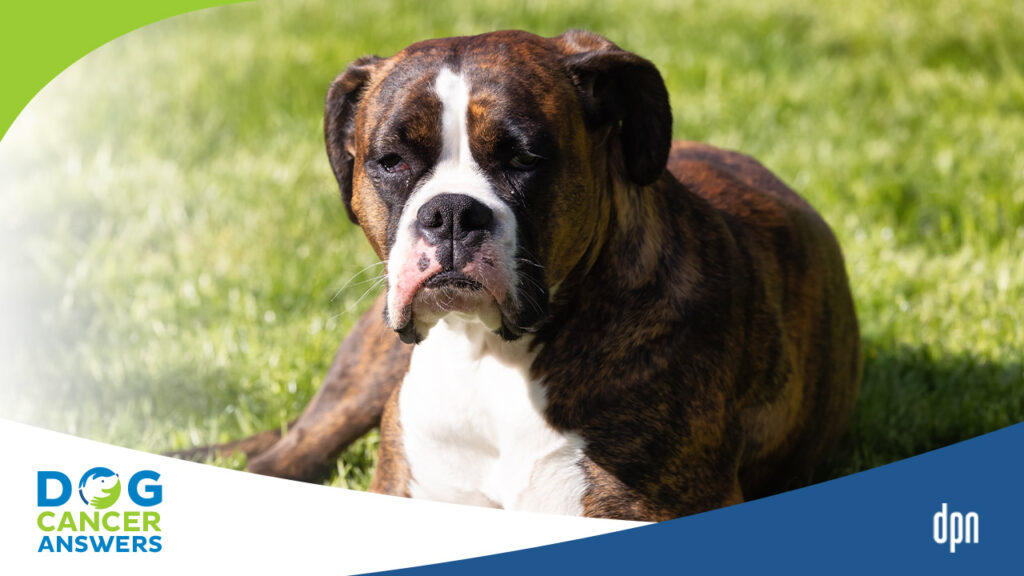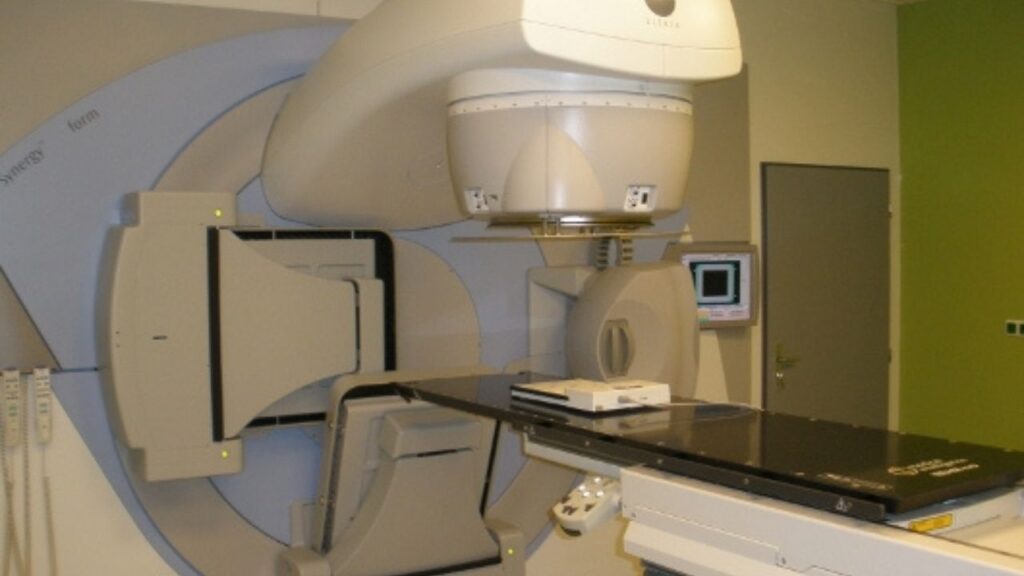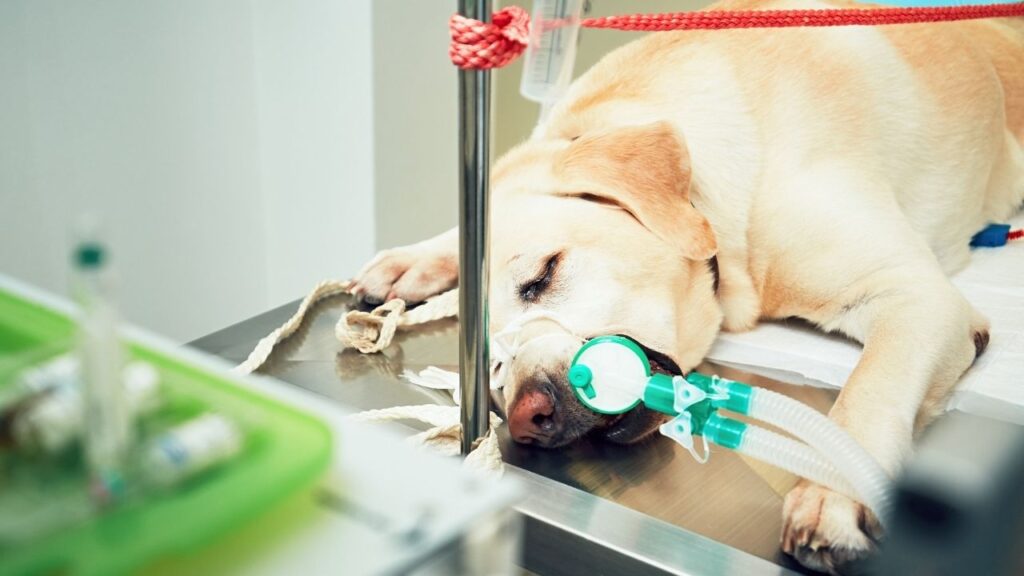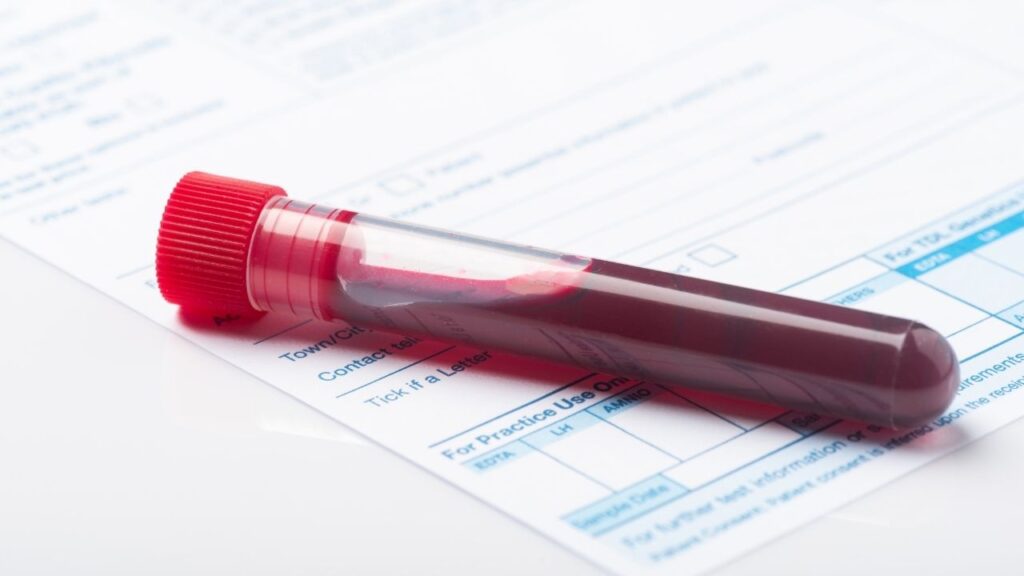Dog hormone therapy is an easy-to-administer treatment option that may help combat your dog’s cancer by manipulating sex steroid hormones associated with tumor growth. Unfortunately, not all tumors will respond to this therapy and we are still learning how it works for dogs.
Key Takeaways
- Hormone therapy for dogs uses medications to manipulate hormones that impact how some cancers grow and spread. It is most likely to be useful for mammary, prostate, uterine, or adrenal cancers.
- Side effects of hormone therapy in dogs can include GI upset, weight gain, muscle loss, fatigue, and bone marrow suppression.
- Dogs have naturally occurring hormones that control different processes in the body throughout their lifetime. All of them have beneficial purposes, but can also have negative effects in some diseases or if the dog has too much or too little of a particular hormone.
- Benefits of hormone therapy can include shrinking tumor size and decreasing the risk of a cancer coming back. These medications are often easily given at home, and some are inexpensive.
Hormones and Dog Cancer
Hormone therapy works by manipulating your dog’s endocrine system. You can think of the endocrine system as the body’s communication network. It constantly secretes hormones that act as messengers to tell the body what to do.1
Increasing or decreasing the level of specific hormones can alter how cells work, including cancer cells.1
Steroid Hormones
Steroid hormones are the group of hormones usually targeted in cancer treatment. There are two main classes of steroid hormones: corticosteroids and sex steroids. Some examples are:
- Cortisol
- Estrogen
- Progesterone
- Testosterone
- Aldosterone
Steroid hormones are the primary focus of hormone therapy because they play large roles in turning certain cancer cell genes “on” and “off.”1
Depending on your dog’s type of tumor, certain hormones may either encourage the tumor to grow or slow its growth.
Veterinarians can take advantage of these relationships to either remove a hormone that contributes to your dog’s cancer or add a hormone that will help fight the cancer.
Sex Steroids
If you have a female dog, you may have heard that spaying her early in life can prevent some cancers. How? Because removing her ovaries removes the primary organs that secrete estrogen and progesterone.
While these two hormones are important for many female biological functions, they’ve also been implicated in mammary tumor development because they can promote the unregulated growth of cancer cells.4
How Dog Hormone Therapy Works
Hormone therapy drugs either remove certain hormones from the body or supplement ones that can aid in fighting cancer.
There are two main ways we can manipulate how hormones impact the body.
Producing Hormones
We can either encourage the body to make more of a hormone that we want, or stop the body from making a hormone we don’t want.
Receptor Binding or Blocking
We can also work with hormone receptor sites. As a hormone floats around the body, it will bind to receptors on the cells where it works and make changes.
We can either encourage a hormone we want to bind more or block a hormone we don’t want to change cells.
Hormones binding to receptors work much like a key in a keyhole. Each hormone is able to “unlock,” or bind to, specific cells in the body. If we use a drug to block the receptors, there is no keyhole that the key fits into.
You can also think of receptors as a “docking station” on the cell membrane or in the cell itself where the hormone can stop in.
When the hormone attaches, it activates a chain of biochemical reactions that execute the message it has been tasked with delivering.
If this receptor is blocked, the message never gets delivered, and the hormone doesn’t effectively influence the cell or its activity.
Hormone therapy works in one of two ways: it blocks or supplements hormones, or prevents hormones from binding to cells.
Stopping Problematic Hormones
As noted above, there are two ways that your veterinarian can stop problematic hormones that may encourage your dog’s cancer to grow: stop hormone production or block the hormone’s receptors.
You may see these therapies referred to as “anti-hormone treatment.”
Stopping Hormones
Inhibiting the production of hormones associated with tumor growth and survival means that those hormones never get a chance to circulate in the body in the first place.3,5
Two main types of drugs are used for this purpose, each with specific benefits to particular cancers and patient characteristics. For example:
- Aromatase inhibitors are commonly used for post-menopausal human breast cancer patients to prevent estrogen production. Letrozole is an example that has been used in both people and dogs.22
- GnRH analogues are used to treat human prostate cancer by blocking testosterone production.
The basic premise in using these drugs is to induce chemical castration.
Dogs who have been spayed or neutered are already physically castrated, meaning that the organ(s) responsible for releasing the greatest percentage of sex steroids in the body is already out of the picture.
However, your dog doesn’t lack these hormones completely, because other organs can also produce sex steroids.
- For example, in addition to the uterus and ovaries, estrogen is also produced in the liver, muscle fat, hair follicles, and adrenal glands.6
- Androgens such as testosterone are produced both in the testes and in the adrenal glands.7
Giving an aromatase inhibitor or GnRH analogue will shut down the relevant hormone production in all of these sites.
Blocking Hormones
Remember that we can also fight problematic hormones by blocking their receptors.
- Selective estrogen receptor modulators are often used for human breast cancer, with Tamoxifen being a common and well-known example of a drug in this category.
- Anti-androgens are typically used for prostate cancer.7
Supplementing Helpful Hormones
Some cancer cases may benefit from having certain hormones supplemented, or increased, in the body.8
For example, progestogens are medications that mimic the hormone progesterone. These medications can help in the treatment of endometrial cancer.9
It is less clear how these hormones help with cancer, but they appear to directly affect tumor cells and indirectly affect the endocrine system.
Does Human Hormone Therapy Apply to Dogs?
Hormone therapy is known to work well in humans, but its efficacy in veterinary medicine is not well understood.
Cancers in humans and dogs are typically similar, but some differences may affect treatment decision-making when using hormone therapy in dogs.
For example, many cases of breast cancer in humans test positive for a protein called human epidermal growth factor receptor 2 (HER2), which promotes the growth of cancer cells.
A homolog of this gene, dog epidermal growth factor receptor 2 (DER2), is found in dogs with 92% similarity to HER2.10
But despite their similarities, they have different biochemical pathways.11 This means that hormone therapy outcomes for human HER2 breast cancer patients may not carry over to dog DER2 mammary cancer patients.
Dr. Susan Ettinger, AKA Dr. Sue Cancer Vet, explains a study looking at HER2/neu and osteosarcoma on DOG CANCER ANSWERS.
The Process of Dog Hormone Therapy
Your veterinarian must prescribe hormone therapy for dog cancer, but you will probably be able to give the medication at home.
Hormone therapy drugs come in pill form or as an injectable shot you’ll give to your dog as directed by your vet.1,2 If your dog needs to go into the clinic frequently as part of their cancer treatment, your veterinary oncologist may administer hormone therapy at the same time as other treatments.
Depending on your dog’s needs, hormone therapy may be prescribed for weeks, months, years, or the duration of their lifetime.1
When Dog Hormone Therapy is Recommended
Hormone therapy is not appropriate for all dog cancer cases and is not a common treatment. Your veterinarian will consider several factors before suggesting hormone therapy. These factors include:
- Type of cancer (most likely mammary, prostate, uterine, or adrenal cancers)1
- Likelihood of cancer reoccurrence after treatment
- Your dog’s age
- Size and location of the tumor
- Lymph node involvement
- Subtype or genetic characteristics of the tumor
Hormone therapy may make a tumor smaller before surgery or radiation, lower the risk of cancer returning, or destroy cancer cells that have spread to other parts of the body.2
Other Uses for Hormone Therapy
Your vet may recommend hormone therapy based on the side effects your dog is experiencing from their cancer or cancer treatment. For example, lack of appetite and difficulty maintaining weight is common for dogs with cancer.4 Hormones can assist with inducing hunger and overcoming this issue.
Hormone therapy may also be considered an adjuvant therapy that can boost traditional cancer treatments. The hormone drug Tamoxifen is commonly used in the treatment of human breast cancer and can help increase the effectiveness of chemotherapy.3
Dog Cancers Hormone Therapy Is Commonly Used For
Hormone therapy is most likely to be useful for cancers that develop in hormone-sensitive tissues, such as:1
- Mammary glands
- Prostate
- Uterine lining
- Adrenal cortex
Hormones can be manipulated within these tissues in the hopes of achieving a particular outcome based on the cancer type and its characteristics.
Hormone Therapy and Mammary Cancer
Although this is an emerging therapy in dogs, currently, we know the most about hormone therapy and mammary cancer.
In human patients diagnosed with ER+ breast cancer, hormone therapy is almost always used.3
Your dog may be diagnosed with mammary cancer that is estrogen receptor positive (ER+) or estrogen receptor negative (ER-).
Your veterinary oncologist might recommend spaying your dog with mammary tumors … or might not. It depends upon whether she has an estrogen-sensitive tumor type.
In a study of 159 female dogs with mammary tumors, estrogen acted as a pro-carcinogen (encouraging cancer) in dogs with ER+ tumors but had a protective effect (limiting cancer) in dogs with ER- tumors.1
This means that removing estrogen from the body with estrogen blockers could be beneficial to a dog with an ER+ mammary tumor, but detrimental to a dog with an ER- mammary tumor.
If your dog has an ER- tumor, your oncologist may even consider supplementing estrogen levels.
We know that spaying decreases the risk of developing mammary cancer in the first place, but whether or not to spay a female dog who has already been diagnosed is a little more complex.
The same study discussed above looked at the outcomes and survival for dogs who were spayed as part of their treatment plan and those that were not.
- For dogs with ER+ tumors and high estrogen levels at the time of diagnosis, spaying (and thus removing primary sources of estrogen in the body) was associated with slower rates of metastasis.12
- For dogs with ER- tumors and high estrogen levels at the time of diagnosis, on the other hand, remaining intact and not being spayed was associated with slower rates of metastasis.12
This means that if your dog has ER+ mammary cancer, she will likely benefit from being spayed and/or receiving anti-hormone therapy to block estrogen.
But if your dog has ER- mammary cancer, being spayed and receiving estrogen blockers may actually be harmful.
Keep in mind that the ER status of your dog’s tumor is just one piece of the cancer treatment puzzle. The ideal treatment plans for individual dogs can vary significantly depending on many other factors.
How to Get the Best Results
Hormone therapy is typically prescribed with other traditional cancer treatments like surgery, radiotherapy, or chemotherapy.2
This is because hormone therapy can have an additive effect, allowing your dog to benefit more from their other treatment(s).
If your dog is prescribed hormone therapy, you’ll want to ensure they aren’t taking any dietary supplements that may have hormones added. Supplements with added hormones may interfere with your dog’s prescribed hormone treatment therapy and should be discontinued.
Home Care
Hormone therapy for dogs does not require much special home care. Monitor your dog for any adverse side effects or behavioral changes, and talk to your vet if you have any concerns.
If your dog receives injectable hormone therapy, there may be some tenderness at the injection site. You can ice this area to alleviate discomfort and may want to avoid petting your dog in painful spots for the first day or two after injection.
Follow Up
Professional monitoring of hormone therapy treatment is mandatory3.
- Your veterinarian will want to monitor the target hormone levels in your dog’s blood to ensure that he or she is responding to therapy.
- The dosages may be tweaked over time to ensure that your dog’s hormone levels are just where the vet wants them: not too high or too low.
Hormone therapy is usually prescribed as long-term therapy, so expect routine follow-up appointments to be part of your dog’s new normal.
How Long Does Hormone Therapy Work?
One important reason for follow-up visits is to ensure your dog’s hormone therapy continues working.
While science has made remarkable strides in manipulating the physiological processes in our bodies, cancer can be relentless.
For example, Lupron and Zoladex are often used with anti-androgens to decrease prostate-specific antigen levels in men. However, these medications are often only effective for 18 to 24 months before antigen levels rise and disease progression starts.14
Keep routine appointments, because if hormone therapy stops working, it’s a waste to keep doing it.
Routine follow-up appointments help you and your veterinarian make plans. After all, if your dog’s therapy stops working, there is no reason to continue spending money on it.
When to Not Use Dog Hormone Therapy
Hormone therapy is unlikely to benefit your dog if his or her cancer does not involve the endocrine system.
For cancers of the reproductive tract, spaying or neutering are often the treatment of choice. Hormone therapy may be used in addition to these procedures, or may not be necessary because the primary source of the hormones has been removed.
Hormone therapy may not be appropriate if your dog also has a hormone disorder such as Cushing’s disease, Addison’s disease, spay incontinence,20 or benign prostatic hyperplasia (BPH)6 that is being treated with hormone medications.
In humans, patients with a high risk of reoccurrence often are not great candidates for hormone therapy.3 However, some drugs are undergoing development for use in patients experiencing a resurgence of their cancer, so this may change in the future.15
Where to Get Hormone Therapy
A veterinarian must prescribe hormone therapy for dogs. Veterinary oncologists are the most likely to have experience using hormone therapy as part of cancer treatment.
You can get hormone therapy drugs for your dog through your vet’s office or on online platforms. Animal pharmacy websites can sometimes be cheaper, and they will contact your vet to ensure a prescription is on file for your dog.
Don’t Go It Alone!
Hormones are powerful substances, and tiny changes in their levels can have big effects in the body. Do not purchase hormone support supplements without your veterinarian’s input.
Hormones are powerful; don’t use hormone support supplements without knowing your dog needs them.
Upsetting the balance of your dog’s endocrine system in the wrong ways can cause your dog more harm than good, and may even encourage cancer growth and spread in some cases.
Safety and Side Effects of Dog Hormone Therapy
Hormone therapy blocks the body’s ability to produce hormones or interferes with hormones’ behavior, so side effects may be inevitable.2
Most side effects are minor and not life-threatening, but you will want to keep your veterinarian informed if any changes occur after starting treatment.
Exact side effects will vary depending on which medication(s) your dog is taking. Some common possibilities noted in humans include:1,2,5,18,19
- Vomiting
- Nausea
- Weight gain
- High blood calcium levels
- Fluid retention
- Vaginal bleeding or discharge
- Blood clots
- Bone marrow suppression
- Osteoporosis
- Anemia
- Fatigue
- Muscle loss
- Diabetes
- Heart abnormalities
- Cognitive decline
In the past, there were concerns about hormone replacement therapy increasing the risk of developing other cancers. Thankfully, correct combinations and doses of estrogen and progestin in human patients are now known to be helpful and are no longer commonly linked to the development of cancer at an unrelated site.
Studies have shown that estrogen therapy does not appear to increase the risk of breast cancer, ovarian cancer (but only in pre-menopausal women), colorectal cancer, skin cancer, or lung cancer.17
Cost of Hormone Therapy
The cost of dog hormone therapy will vary depending on which medication(s) your dog is receiving and where you live.
- For example, if your dog receives methimazole as part of thyroid cancer treatment, a one-month supply might be under $10.
- Letrozole, on the other hand, can run over $100 a month.
- Some hormone therapy drugs used in humans (which may or may not be safe for use in dogs) can run as much as $1,000 a month.
Also, remember that your dog will require regularly scheduled bloodwork and exams to ensure their hormone therapy is working as intended.
Discuss any cost concerns with your veterinarian to determine if hormone therapy is going to be practical for you and your dog.
- Hormone Therapy. American Cancer Society. https://www.cancer.org/treatment/treatments-and-side-effects/treatment-types/hormone-therapy.html. Published July 21, 2020. Accessed March 8, 2023.
- No author. Hormone Therapy to Treat Cancer. National Cancer Institute. August 23, 2022. https://www.cancer.gov/about-cancer/treatment/types/hormone-therapy. Accessed January 12, 2023.
- Draganuscu M, Carmocan C. Hormone therapy in breast cancer. Chirugia 2017;112.413-417.
- Dressler D, Ettinger S. The Dog Cancer Survival Guide. Maui Media;2011.
- Nelson CJ, Lee JS, Gamboa MC, Roth AJ. Cognitive effects of hormone therapy in men with prostate cancer. Am Cancer Soc 2008;113(5):1097-1106.
- McDonald LE. Estrogens. In: Booth NH, McDonald LE, eds. Veterinary Pharmacology and Therapeutics. 6th ed. Iowa State University Press; 1988:598–604.
- Miyamoto H, Messing EM, Chang C. Androgen deprivation therapy for prostate cancer: current status and future prospects. Prostate. 2004;61:332-353.
- DeVita VT, Hellman S, Rosenberg SA. Cancer: principles & practice of oncology. Lippincott; 2005.
- Brunton LL, Lazo JS, Parker KL. Goodman & Gilman’s The Pharmacological Basis of Therapeutics. 11th ed. The McGraw-Hill Companies, Inc; 2006.
- Fazekas J, Fürdös I, Singer J, Jensen-Jarolim E. Why man’s best friend, the dog, could also benefit from an anti-HER-2 vaccine. Oncol Lett 2016;12(4):2271-2276. doi:10.3892/ol.2016.5001.
- Burrai GP, De Miglio MR, Abbondio M, et al. Investigation of HER2 expression in canine mammary tumors by antibody-based, transcriptomic and mass spectrometry analysis: is the dog a suitable animal model for human breast cancer? Tumor Biol 2015;36:9083-9091.
- Serenmo KU, Durham AC, Radaelli E, Kristiansen V, Peña L, Goldschmidt MH, Stefanovski S. The estrogen effect; clinical and histopathological evidence of dichotomous influences in dogs with spontaneous mammary carcinomas. PLoS ONE 2019;14(10):e0224505.
- Early Breast Cancer Trialists’ Collaborative Group (EBCTCG). Effects of chemotherapy and hormonal therapy for early breast cancer on recurrence and 15-year survival: an overview of the randomised trials. Lancet 2005;365(9472):1687-717
- Pomerantz M, Kantoff P. Advances in the treatment of prostate cancer. Annu Rev Med 2007;58:205-220.
- James ND, de Bono JS, Spears MR. Abiraterone for prostate cancer not previously treated with hormone therapy. N Engl J Med 2017;377:338-351.
- Holzman BG, Ravitch MM, Metheny W, Rothert ML, Holmes M, Hoppe RB. Physicians’ judgments about estrogen replacement therapy for menopausal women. Obstet Gynecol 1984;63:303-311.
- No author. Menopausal hormone therapy and cancer risk. American Cancer Society. February 13, 2015. https://www.cancer.org/healthy/cancer-causes/medical-treatments/menopausal-hormone-replacement-therapy-and-cancer-risk.html. Accessed January 12, 2023.
- Sontas HB, Dokuzeylu B, Turna O, Ekici H. Estrogen-induced myelotoxicity in dogs: A review. Can Vet J 2009;50(10):1054-1058.
- Holzbeierlein JM, Castle E, Thrasher JB. Complications of androgen deprivation therapy: prevention and treatment. Oncology 2004;18:303-309.
- No author. Hormone Restoration in Dogs. Parsemus Foundation. No publication date available. https://www.parsemus.org/pethealth/hormone-restoration-in-dogs/. Accessed on January 12, 2023.
- Diaby V, Tawk R, Sanogo V, Xiao H, Montero AJ. A review of systematic reviews of the cost-effectiveness of hormone therapy, chemotherapy, and targeted therapy for breast cancer. Breast Cancer Res Treat 2015;151:270-40.
- Caceres S, Monsalve B, Alonso-Diez A, et al. Blocking estrogen synthesis leads to different hormonal responses in canine and human triple negative inflammatory breast cancer. Cancers. 2021;13(19):4967. doi:10.3390/cancers13194967
Topics
Did You Find This Helpful? Share It with Your Pack!
Use the buttons to share what you learned on social media, download a PDF, print this out, or email it to your veterinarian.









